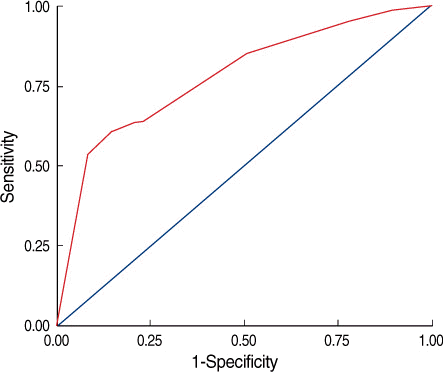1. Moran MS, Haffty BG. Local-regional breast cancer recurrence: prognostic groups based on patterns of failure. Breast J. 2002; 8:81–87.

2. Recht A, Gray R, Davidson NE, Fowble BL, Solin LJ, Cummings FJ, et al. Locoregional failure ten years after mastectomy and adjuvant chemotherapy with or without tamoxifen without radiation: experience of the Eastern Cooperative Oncology Group. J Clin Oncol. 1999; 17:1689–1700.
3. Shim SJ, Kim YB, Keum KC, Lee IJ, Lee HD, Suh CO. Validation of radiation volume by analysis of recurrence pattern in breast-conserving treatment for early breast cancer. J Breast Cancer. 2009; 4:257–264.

4. Galper S, Recht A, Silver B, Manola J, Gelman R, Schnitt SJ, et al. Factors associated with regional nodal failure in patients with early stage breast cancer with 0-3 positive axillary nodes following tangential irradiation alone. Int J Radiat Oncol Biol Phys. 1999; 45:1157–1166.

5. Halverson KJ, Taylor ME, Perez CA, Garcia DM, Myerson R, Philpott G, et al. Regional nodal management patterns of failure following conservative surgery and radiation therapy for stage I and II breast cancer. Int J Radiat Oncol Biol Phys. 1993; 26:593–599.
6. Grills IS, Kestin LL, Goldstein N, Mitchell C, Martinez A, Ingold J, et al. Risk factors for regional nodal failure after breast conserving therapy: regional nodal irradiation reduces rate of axillary failure in patients with four or more positive lymph nodes. Int J Radiat Oncol Biol Phys. 2003; 56:658–670.
7. Schlembach PJ, Buchholz TA, Ross MI, Kirsner SM, Salas GJ, Strom EA, et al. Relationship of sentinel and axillary level I-II lymph nodes to tangential fields used in breast irradiation. Int J Radiat Oncol Biol Phys. 2001; 51:671–678.

8. Coen JJ, Taghian AG, Kachnic LA, Assaad SI, Powell SN. Risk of lymphedema after regional nodal irradiation with breast conservation therapy. Int J Radiat Oncol Biol Phys. 2003; 55:1209–1215.
9. Kim HJ, Jang WI, Kim TJ, Kim JH, Kim SW, Moon SH, et al. Radiation-induced pulmonary toxicity and related risk factors in breast cancer. J Breast Cancer. 2009; 2:67–72.

10. Johansson S, Svensson H, Denekamp J. Dose response and latency for radiation-induced fibrosis, edema, and neuropathy in breast cancer patients. Int J Radiat Oncol Biol Phys. 2002; 52:1207–1219.

11. Frederick LG, David LP, Irvin DF, April F, Charles MB, Daniel GH, et al. In: AJCC Cancer Staging Manual/American Joint Committee on Cancer. 6th ed. Philadelphia: Lippincott Williams & Wilkins; 2002. pp. 223-240.
12. Kambouris AA. Axillary node metastases in relation to size and location of breast cancers: analysis of 147 patients. Am Surg. 1996; 7:519–524.
13. Fein DA, Fowble BL, Hanlon AL, Hooks MA, Hoffman JP, Sigurdson ER, et al. Identification of women with T1-T2 breast cancer at low risk of positive axillary nodes. J Surg Oncol. 1997; 1:34–39.

14. Cetintaş SK, Kurt M, Ozkan L, Engin K, Gökgöz S, Taşdelen I. Factors influencing axillary node metastasis in breast cancer. Tumori. 2006; 92:416–422.

15. Jonjic N, Mustac E, Dekanic A, Marijic B, Gaspar B, Kolic I, et al. Predicting sentinel lymph node metastases in infiltrating breast carcinoma with vascular invasion. Int J Surg Pathol. 2006; 14:306–311.

16. Silverstein MJ, Skinner KA, Lomis TJ. Predicting axillary nodal positivity in 2282 patients with breast carcinoma. World J Surg. 2001; 25:767–772.

17. Shahar KH, Hunt KK, Thames HD, Ross MI, Perkins GH, Kuerer HM, et al. Factors predictive of having four or more positive axillary lymph nodes in patients with positive sentinel lymph nodes: implications for selection of radiation fields. Int J Radiat Oncol Biol Phys. 2004; 59:1074–1079.

18. Katz A, Niemierko A, Gage I, Evans S, Shaffer M, Smith FP, et al. Factors associated with involvement of four or more axillary nodes for sentinel lymph node-positive patients. Int J Radiat Oncol Biol Phys. 2006; 65:40–44.

19. Katz A, Smith BL, Golshan M, Niemierko A, Kobayashi W, Raad RA, et al. Nomogram for the prediction of having four or more involved nodes for sentinel lymph node-positive breast cancer. J Clin Oncol. 2008; 26:2093–2098.






 PDF
PDF ePub
ePub Citation
Citation Print
Print


 XML Download
XML Download